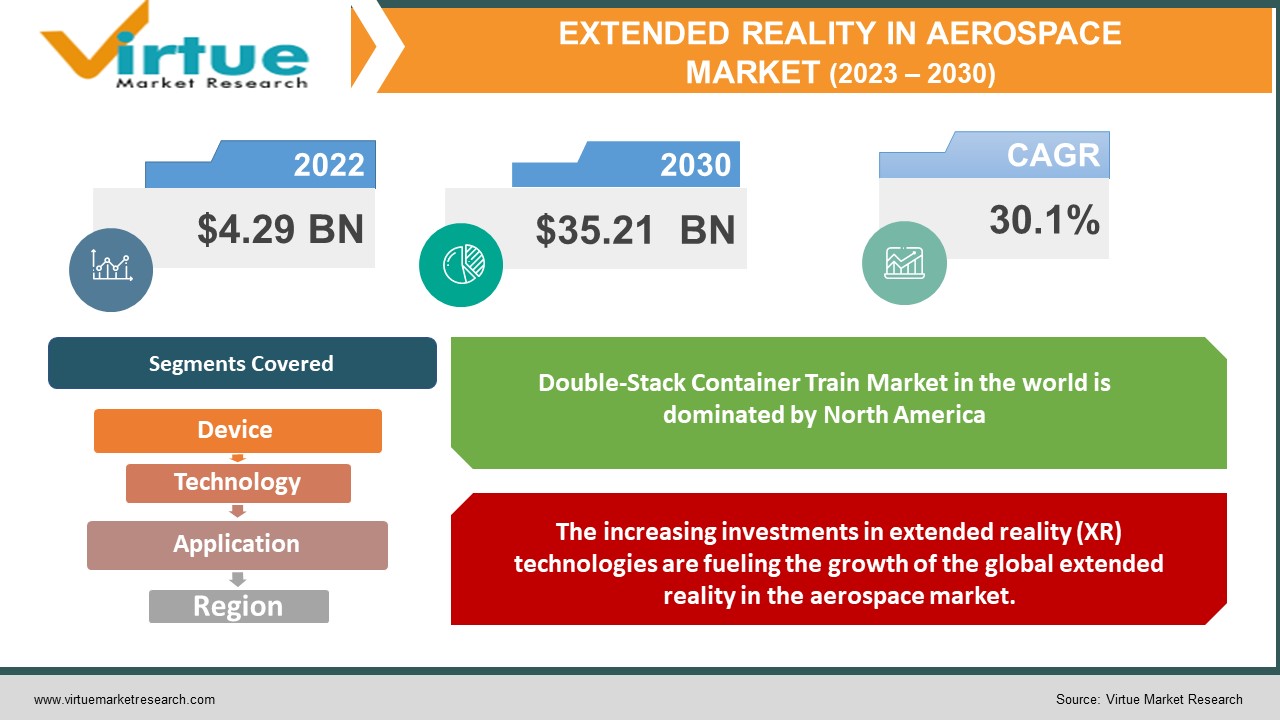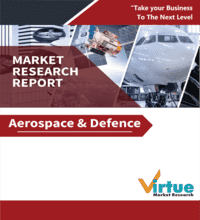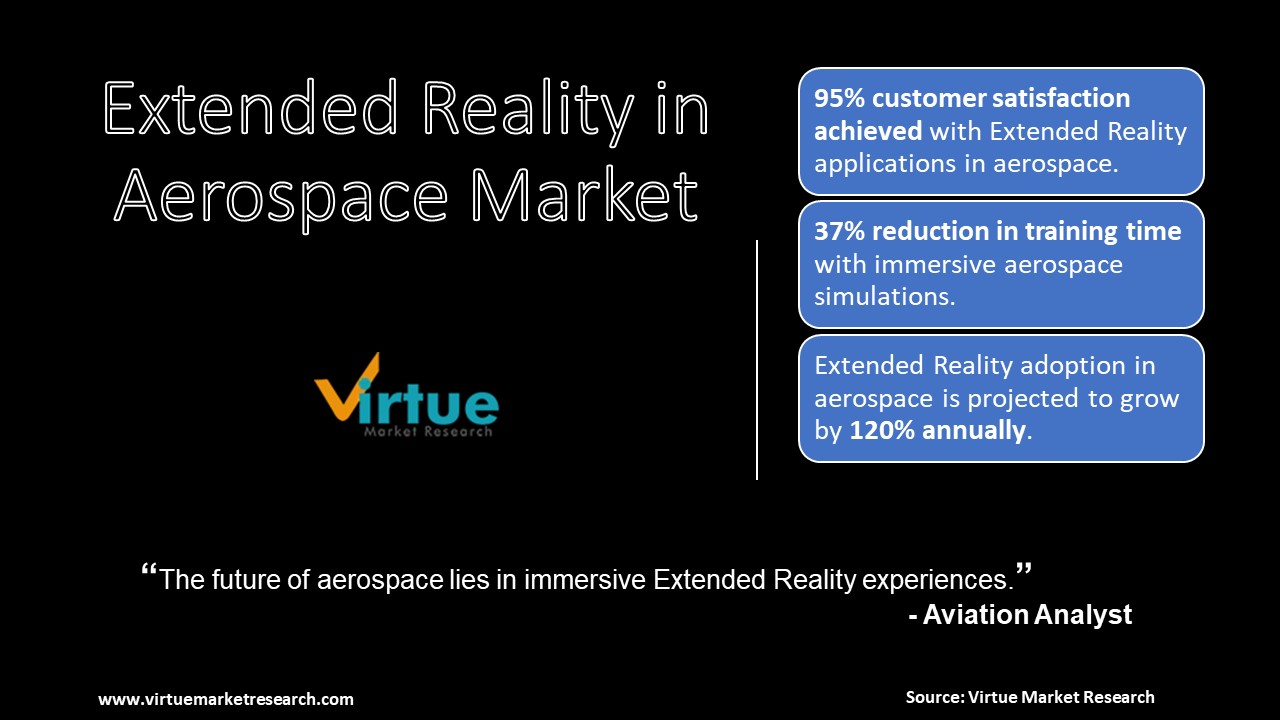Global Extended Reality in Aerospace Market Size (2023-2030)
Global Extended Reality in Aerospace Market is estimated to be worth USD 4.29 Billion in 2022 and is projected to reach a value of USD 35.21 Billion by 2030, growing at a CAGR of 30.1% during the forecast period 2023-2030.

Extended Reality (XR), encompassing virtual reality (VR), augmented reality (AR), and mixed reality (MR), has immense transformative potential in the aerospace industry. It revolutionizes training, design, and aircraft development by creating simulated environments. XR's benefits include simulating complex systems for cost-effective testing, providing safe training environments, enabling interactive 3D modeling for superior designs, and creating digital twins for performance monitoring and issue detection. Aerospace professionals must embrace XR's potential to drive future advancements in the industry.
In summary, XR has the power to revolutionize the aerospace industry, offering safe and inexpensive solutions for training, design, and development. By harnessing the capabilities of virtual reality, augmented reality, and mixed reality, XR opens up new possibilities for simulating and optimizing complex aircraft systems, improving training effectiveness, streamlining design processes, and enhancing performance monitoring. Embracing XR technology will be crucial for aerospace professionals to stay at the forefront of innovation and leverage its benefits for continued advancements in the industry.
Global Extended Reality in Aerospace Market Drivers:
The increasing investments in extended reality (XR) technologies are fueling the growth of the global extended reality in the aerospace market.
Extended Reality (XR) has become increasingly popular and has attracted significant investment globally. Business firms across industries are exploring the capabilities of virtual reality (VR), augmented reality (AR), and mixed reality (MR) technologies. XR finds applications in immersive training, research and development, virtual collaboration, entertainment, and remote assistance. Industries are also leveraging XR to offer customers pre-purchase testing experiences. This not only enhances consumer satisfaction but also reduces product returns. Investors are taking notice of these opportunities in sectors like aerospace, e-commerce, education entertainment, healthcare, sports, and tourism. Therefore, this factor drives the demand for extended reality in aerospace.
The advantages of utilizing extended reality (XR) technologies in the aerospace industry are another factor contributing to the growth of the global extended reality in the aerospace market.
Virtual reality (VR), augmented reality (AR), and mixed reality (MR) technologies in aerospace optimize operations, leading to cost savings across manufacturing, maintenance, airport, airline, and training functions. These immersive technologies improve task efficiency, resulting in smoother airport and airline operations. This increased efficiency allows aircraft to spend more time flying, generating higher revenue by minimizing grounded time. VR/AR/MR integration enhances the overall effectiveness of the aerospace industry, improving operational performance and financial outcomes. Therefore, this factor also drives the demand for extended reality in aerospace.
Global Extended Reality in Aerospace Market Challenges:
The global extended reality in the aerospace market is encountering challenges, primarily in terms of health problems resulting from excessive utilization of extended reality devices. The development of advanced extended reality devices has raised health concerns due to potential risks and discomfort associated with their utilization. One risk is the possibility of users colliding with real objects while engrossed in the virtual world, leading to injuries. After utilizing these gadgets, users frequently suffer headaches, eye strain, dizziness, and nausea. Research from the University of Leeds indicates that as little as 20 minutes of virtual reality exposure can affect children's depth perception. Moreover, the regular utilization of these devices is predicted to contribute to the global rise of myopia (near-sightedness). Thus, these challenges inhibit the growth of the global extended reality in the aerospace market.
Global Extended Reality in Aerospace Market Opportunities:
The utilization of virtual reality (VR) technology for passengers' entertainment presents a lucrative opportunity in the global extended reality in the aerospace market. Commercial airlines are embracing VR technology to enhance the flight experience for passengers, particularly those who are afraid of flying. By utilizing VR headsets, airlines create an entertaining and relaxing environment during the flight. Air France serves as an example of successful implementation, using VR to entertain and alleviate anxiety in anxious passengers. The integration of VR has greatly improved the overall flight experience for individuals with a fear of flying.
COVID-19 Impact on the Global Extended Reality in Aerospace Market:
The outbreak of the COVID-19 pandemic substantially impacted the global extended reality in the aerospace market. The pandemic caused disruptions in supply chains and distribution of goods and services, which highly affected the implementation of extended reality in the aerospace industry. Moreover, the pandemic caused a financial strain in the aerospace industry, potentially hampering XR technology innovation due to reduced research and development activities and investment caused by budget limitations and cost-cutting measures. These factors negatively impacted the growth of the global extended reality in the aerospace market. Despite these challenges, the global extended reality in the aerospace market is projected to recover and grow in the coming years.
Global Extended Reality in Aerospace Market Recent Developments:
- In March 2023, Kopin Corporation, a US-based prominent provider of optical systems, made notable advancements in qualifying its high-performance Organic Light Emitting Diode (OLED) display for the F-35 Joint Strike Fighter's Helmet Mounted Display System (HMDS). This achievement demonstrates Kopin's dedication to delivering cutting-edge display technology for defense applications in the aerospace industry, emphasizing its industry-leading position.
- In November 2022, The US Air Force awarded a research and development contract to SimX, a virtual reality (VR) medical simulation company. SimX will enhance its VR medical simulation training program to meet the specific requirements of tactical combat casualty care. The objective of the contract is to create an adaptable and replicable platform that responds to the particular requirements of this field and advances military medical education.
- In September 2022, The Boeing Company, the world's largest aerospace company based in the United States, collaborated with Red 6, a US-based augmented reality (AR) company, to develop AR pilot training systems for the US T-7 and F-15EX combat jets. Red 6's first collaboration with Boeing features its ARCADE and ATARS technologies. The agreement allows these systems to be integrated into Boeing aircraft, providing AR training aids to the T-7 and F-15EX platforms.
EXTENDED REALITY IN AEROSPACE MARKET REPORT COVERAGE:
|
REPORT METRIC |
DETAILS |
|
Market Size Available |
2022 - 2030 |
|
Base Year |
2022 |
|
Forecast Period |
2023 - 2030 |
|
CAGR |
30.1% |
|
Segments Covered |
By Device, Technology, Application, and Region |
|
Various Analyses Covered |
Global, Regional & Country Level Analysis, Segment-Level Analysis, DROC, PESTLE Analysis, Porter’s Five Forces Analysis, Competitive Landscape, Analyst Overview on Investment Opportunities |
|
Regional Scope |
North America, Europe, APAC, Latin America, Middle East & Africa |
|
Key Companies Profiled |
Microsoft Corporation (United States) , Unity Technologies (United States) , Kopin Corporation (United States) , Accenture plc (Ireland) , PTC Inc. (United States) , TXT e-solutions (Italy) , Vection Technologies Ltd. (Australia) , Tecknotrove System (I) Pvt Ltd (India) , SkyLights (United States) , Optivent (France) |
Global Extended Reality in Aerospace Market Segmentation:
Global Extended Reality in Aerospace Market Segmentation: By Device
- Handheld Devices
- Head-Mounted Displays
- Head-Up Displays
- Smart Glasses
Based on the device, the global extended reality in the aerospace market is segmented into handheld devices, head-mounted displays, head-up displays, and smart glasses. In 2022, the head-mounted displays segment held the highest market share. The growth can be attributed to the immersive experience and real-life environment that head-mounted displays offer to individuals in contrast to other technologies, enhancing the effectiveness of several applications, including pilot training, cabin crew training, and in-flight entertainment. Additionally, head-mounted displays are very convenient and affordable in contrast to other XR-based technological devices, which makes them easily accessible to aerospace professionals.
Global Extended Reality in Aerospace Market Segmentation: By Technology
- Virtual Reality (VR)
- Augmented Reality (AR)
- Mixed Reality (MR)
Based on the technology, the global extended reality in the aerospace market is segmented into virtual reality (VR), augmented reality (AR), and mixed reality (MR). In 2022, the virtual reality (VR) segment held the highest market share. The growth can be attributed to the extensive utilization of VR technology in aircraft design and simulation. VR technology has revolutionized aircraft design and simulation, resulting in time and cost savings, improved safety, and precision. VR allows engineers to create realistic simulations of flight characteristics, refining designs before physical construction. It facilitates virtual flight environments for observing aircraft behavior. VR's use is advantageous in new aircraft development, reducing expenses by replacing physical prototypes and airborne tests. Simulations of individual components fine-tune designs, ensuring optimal performance. VR also creates virtual cockpit models for pilot training. Overall, VR integration in aircraft design saves resources and enhances safety, and as technology advances, its applications will continue to advance in effectiveness.
Global Extended Reality in Aerospace Market Segmentation: By Application
- Aircraft Design and Simulation
- Aircraft Maintenance and Repair
- Cabin Crew Training
- In-flight Entertainment
- Pilot Training
- Others
Based on the application, the global extended reality in the aerospace market is segmented into aircraft design and simulation, aircraft maintenance and repair, pilot training, and others. In 2022, the pilot training segment held the highest market share. The growth can be attributed to the increasing demands of pilot training and flight safety in the expanding aerospace industry. To meet these demands, extended reality (XR) technologies, such as augmented reality (AR), virtual reality (VR), and mixed reality (MR), are being extensively adopted. AR overlays real-time digital information in the cockpit, aiding operational procedures and alerting pilots to hazards. VR creates realistic simulated cockpit environments for practicing maneuvers, navigation, and communication with air traffic control. MR combines AR and VR, merging physical and digital elements to enhance pilots' understanding of aircraft instrumentation. By embracing XR, airlines, training centers, and flight schools revolutionize pilot training, offering immersive learning environments while improving safety for passengers and crew.
Global Extended Reality in Aerospace Market Segmentation: By Region
- North America
- Europe
- Asia-Pacific
- South America
- Middle East & Africa
The region of North America held the largest share of the global extended reality in the aerospace market in the year 2022. The presence of well-established aviation industries in nations, such as the United States and Canada, the early and wide adoption of advanced technologies like virtual reality (VR), augmented reality (AR), and mixed reality (MR), the increasing deployment of extended reality in a variety of applications, and the increasing investments in research and development activities are some of the factors propelling the region's growth. Additionally, North America is home to several significant market players, including Microsoft Corporation, Unity Technologies, Kopin Corporation, PTC Inc., and SkyLights.
Due to the growing aviation industry in nations, such as China, India, and Japan, the rising adoption of advanced technologies like extended reality (XR) for enhancing training, safety, and operational efficiency, and the strong presence of major market players, including Vection Technologies Ltd., Tecknotrove System (I) Pvt Ltd, and Seiko Epson Corporation, the region of Asia-Pacific is anticipated to expand at the fastest rate over the forecast period.
Global Extended Reality in Aerospace Market Key Players:
- Microsoft Corporation (United States)
- Unity Technologies (United States)
- Kopin Corporation (United States)
- Accenture plc (Ireland)
- PTC Inc. (United States)
- TXT e-solutions (Italy)
- Vection Technologies Ltd. (Australia)
- Tecknotrove System (I) Pvt Ltd (India)
- SkyLights (United States)
- Optivent (France)
Chapter 1. EXTENDED REALITY IN AEROSPACE MARKET – Scope & Methodology
1.1. Market Segmentation
1.2. Assumptions
1.3. Research Methodology
1.4. Primary Sources
1.5. Secondary Sources
Chapter 2. EXTENDED REALITY IN AEROSPACE MARKET – Executive Summary
2.1. Market Size & Forecast – (2023 – 2030) ($M/$Bn)
2.2. Key Trends & Insights
2.3. COVID-19 Impact Analysis
2.3.1. Impact during 2023 – 2030
2.3.2. Impact on Supply – Demand
Chapter 3. EXTENDED REALITY IN AEROSPACE MARKET – Competition Scenario
3.1. Market Share Analysis
3.2. Product Benchmarking
3.3. Competitive Strategy & Development Scenario
3.4. Competitive Pricing Analysis
3.5. Supplier - Distributor Analysis
Chapter 4. EXTENDED REALITY IN AEROSPACE MARKET - Entry Scenario
4.1. Case Studies – Start-up/Thriving Companies
4.2. Regulatory Scenario - By Region
4.3 Customer Analysis
4.4. Porter's Five Force Model
4.4.1. Bargaining Power of Suppliers
4.4.2. Bargaining Powers of Customers
4.4.3. Threat of New Entrants
4.4.4. Rivalry among Existing Players
4.4.5. Threat of Substitutes
Chapter 5. EXTENDED REALITY IN AEROSPACE MARKET - Landscape
5.1. Value Chain Analysis – Key Stakeholders Impact Analysis
5.2. Market Drivers
5.3. Market Restraints/Challenges
5.4. Market Opportunities
Chapter 6. EXTENDED REALITY IN AEROSPACE MARKET – by Device
6.1. Handheld Devices
6.2. Head-Mounted Displays
6.3. Head-Up Displays
6.4. Smart Glasses
Chapter 7. EXTENDED REALITY IN AEROSPACE MARKET – By Technology
7.1. Virtual Reality (VR)
7.2. Augmented Reality (AR)
7.3. Mixed Reality (MR)
Chapter 8. EXTENDED REALITY IN AEROSPACE MARKET – By Application
8.1. Aircraft Design and Simulation
8.2. Aircraft Maintenance and Repair
8.3. Cabin Crew Training
8.4. In-flight Entertainment
8.5. Pilot Training
8.6. Others
Chapter 9. EXTENDED REALITY IN AEROSPACE MARKET – By Region
9.1. North America
9.2. Europe
9.3.The Asia Pacific
9.4.Latin America
9.5. Middle-East and Africa
Chapter 10. EXTENDED REALITY IN AEROSPACE MARKET– Company Profiles – (Overview, Product Portfolio, Financials, Developments)
10.1. Microsoft Corporation (United States)
10.2. Unity Technologies (United States)
10.3. Kopin Corporation (United States)
10.4. Accenture plc (Ireland)
10.5. PTC Inc. (United States)
10.6. TXT e-solutions (Italy)
10.7. Vection Technologies Ltd. (Australia)
10.8. Tecknotrove System (I) Pvt Ltd (India)
10.9. SkyLights (United States)
10.10. Optivent (France)
Download Sample
Choose License Type
2500
4250
5250
6900
Frequently Asked Questions
Global Extended Reality in Aerospace Market is estimated to be worth USD 4.29 Billion in 2022 and is projected to reach a value of USD 35.21 Billion by 2030, growing at a fast CAGR of 30.1% during the outlook period 2023-2030.
The Global Extended Reality in Aerospace Market Drivers are the Increasing Investments in Extended Reality (XR) technologies and the Advantages of Utilizing XR technologies in the Aerospace Industry.
Based on the Technology, the Global Extended Reality in Aerospace Market is segmented into Virtual Reality (VR), Augmented Reality (AR), and Mixed Reality (MR).
The United States is the most dominating country in the region of North America for the Global Extended Reality in Aerospace Market.
Microsoft Corporation, Unity Technologies, and Kopin Corporation are the leading players in the Global Extended Reality in Aerospace Market.




